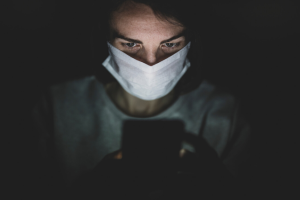Is Worrying About the World Impacting Your Emotional Wellbeing?
 From current events to politics, there is no shortage of anxiety-inducing information in the world. At times, it can feel like our senses are being bombarded with worrisome news. How much worry is too much? How can we cope? This can certainly be more difficult for those who have lacked secure attachment in childhood or have experienced trauma during their lives. In fact, those with insecure, avoidant, or disorganized attachment, attachment wounds, or trauma histories will have a harder time re-regulating their nervous systems.
From current events to politics, there is no shortage of anxiety-inducing information in the world. At times, it can feel like our senses are being bombarded with worrisome news. How much worry is too much? How can we cope? This can certainly be more difficult for those who have lacked secure attachment in childhood or have experienced trauma during their lives. In fact, those with insecure, avoidant, or disorganized attachment, attachment wounds, or trauma histories will have a harder time re-regulating their nervous systems.
How to Stop Worrying Too Much
Here’s the good news…No matter what, it is possible to be less affected by the state of the world and stay more emotionally even-keeled!
Today, I’m going to help you understand where emotional regulation comes from, talk about how to recognize if your worry or anxiety level has become too high, and also provide tips to help support your emotional regulation on a daily basis.
How Much Worry is “Normal”?
“Normal” worry waves in and out. “Normal” worry is about something specific and realistic. It doesn’t impede daily functioning. If you are experiencing “normal” worry, you might see or hear something that slightly upsets or concerns you, but you can usually problem solve or even ask that kind of worry to step aside; you can breathe through it and can move on with your day. If you have the ability to do this, it means you are likely able to regulate your emotions on a consistent basis, where your thoughts and feelings are able to co-exist and even work together. It means you have the ability to think and feel at the same time so that your feelings and reactions are tolerable and flexible.
Emotional Regulation Starts in Childhood with Secure Attachment
Emotional regulation isn’t automatically part of who we are —it’s taught throughout life, either directly or indirectly. The ability to emotionally regulate comes significantly easier to those who have grown up with secure attachment.
Secure Attachment, as defined by John Bowlby and Mary Ainsworth: Secure attachment is classified by children who show some distress when their caregiver leaves but are able to compose themselves and do something knowing that their caregiver will return. Children with secure attachment feel protected by their caregivers, and they know that they can depend on them to return.
Secure attachment plays a critical role in emotional regulation because it’s the earliest time a child learns that even though they are upset, things will return to normal and that ultimately, they are safe and protected. Attachment styles have a profound effect, not only on our emotional development, but also upon the health of our relationships. For more on this, read my recent post: Loving a Trauma Survivor: Understanding Childhood Trauma’s Impact on Relationships.
The Trauma Connection
If you experienced trauma at some point in your life, this can also make hyperarousal more likely (and emotional regulation more challenging), because, at its most basic, if something bad has happened to you, your body is more likely to feel that something bad will happen again. Certain triggers may cause an even more heightened state of anxiety than a trauma survivor is used to, because your body recalls the feelings of anxiety/worry you have experienced in the past (which is further explained in detail in in Babette Rothschild’s book, The Body Remembers). Learning to cope in a healthy way with these triggers is essential to achieving emotional regulation.
Lack of secure attachment has even been proven to predict severity of PTSD in soldiers. “Soldiers with an insecure attachment style (preoccupied, fearful avoidant, dismissing avoidant) had statistically significantly higher rates of PTSD than soldiers with a secure attachment style.”
Are you Experiencing “Too Much” Worry?
Everyone worries sometimes. But a reliable sign that your worrying has become “too much” is if it sticks around for a long time and impacts your daily functioning. If you are feeling edgier or overwhelmed, and the anxiety has a hard time leaving your brain at all, or unless you’re actively doing something else that takes your mind off of it, this is characterized as “too much” worry.
If you have stopped going to certain places or doing certain things because of worry (like you have stopped flying or started taking a different route home, because you worry so much about those things)—this is a sign that you are having a hard time regulating your emotions and may need some help. Anxiety is diffuse in nature; maybe there isn’t even a clear reason you are feeling distressed at a particular time. Anxiety has physical symptoms, too—trouble with sleep, appetite, tense muscles, irritability, and trouble concentrating to name a few.
If Your Hyperarousal or Anxiety is not Remitting—What Do You Do?
Setting boundaries to help you feel safe is an excellent, important and confident first step. Here are some tips and techniques that I recommend:
- Turn off the news. We get our news through too many senses. The television, in particular, bombards our eyes and ears with information. Getting news through one sense at a time is the safest way to emotionally tolerate difficult information. Personally, I get most of my news by readingor
- Employ the one-time rule.Not only is news coming through too many senses, the frequency is a significant issue. In our 24-hour news cycle, the news repeats again and again. Each time, our neural pathways are impacted. Listen once. Read it once. And if you must watch it—watch it just once.
- Movies and TV.Even though they are fictitious, TV shows like Law & Order (or so many others) can heighten anxiety. If you want to watch an episode, keep it at just one. Marathons are simply too much hyperarousal and can make regulation difficult. The same goes for high-intensity movies. For example, I recently saw the new Jason Bourne movie. Its goal was to heighten my anxiety and my senses. Because of its duration and intensity, this can be particularly difficult to come down from, especially if you are subjecting yourself to frequent stimuli.
- Ground yourself to the present. Breathing from your diaphragm (like Elmo from Sesame Street demonstrates in this video) will help bring you back to the present moment, so you can notice the present tense and know that you are currently safe. Some people find a grounding tool helpful—whether it’s a pair of fuzzy slippers, a rock in your pocket or something as simple as a reminder of someone you feel safe with.
- Keep your evenings positive.Each night, look for positives in the world. Before you go to bed, think about something that you’re grateful for or can appreciate. Don’t use electronic devices like TVs, iPads or video games at night. Instead, create a nighttime routine that lets your body find peace and relaxation—whether this means stretching, yoga, meditation, singing or drinking a cup of herbal tea.
Even in a world full of terrorism, political chaos and natural disasters—it is possible to find a calm place that allows you to see the world’s beauty, to ground yourself in the present, to be mindful and to feel safe. It just takes time and practice.
Is Worry Consuming You or a Loved One?
There is no room for shame or feelings of weakness in this scenario. In fact, it is strength that allows you to recognize when a situation has escalated to where you could use some support. Seeking assistance when you need it is an act of courage, and I can assure you that my office is a place where that courage will be recognized, where we will help you create tools to make a safe and stable environment, within therapy and to use in your daily life.
More Resources
Meditation – Tara Brach’s website
Yoga – Yoga International
Johnson’s groundbreaking and remarkably successful book/program for creating stronger, more secure relationships: Hold Me Tight: Seven Conversations for a Lifetime of Love
Tags: anxiety, stress, worried, worry









Leave a Reply